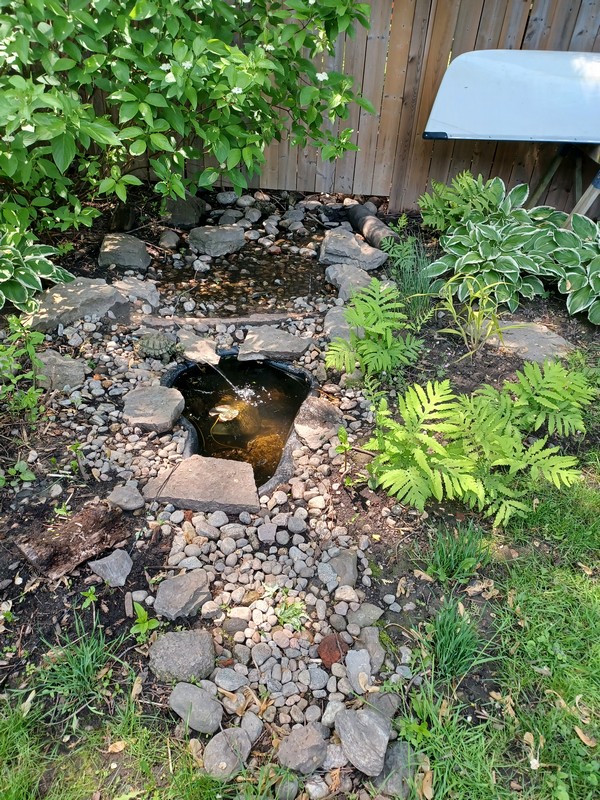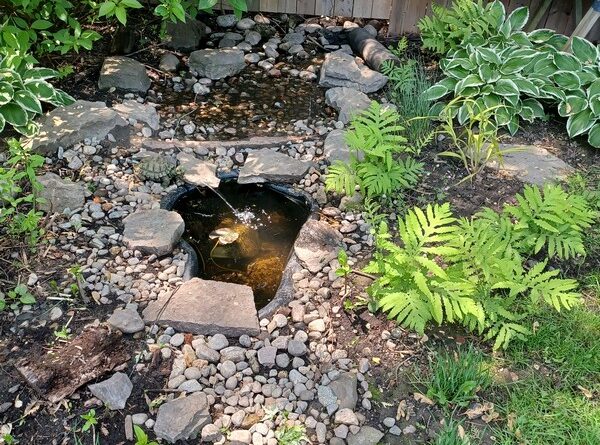Tales of a Sandy Hill backyard garden
The evolution of a pond
Gabrielle Dewalt
In 2001, my husband and I bought a house in Sandy Hill with a grassy backyard shaded by a massive silver maple and surrounded on two sides by unkempt cedar trees. For many years our backyard remained mostly in grass with a hedge at the back and a vegetable garden at the side. Then something unexpected happened.
Three of the houses behind us were bought by a developer who built additions onto the back of each property and paved the backyards with asphalt. The following spring our backyard, which is in a natural hollow, began to flood more than usual, and our shed was threatened by flooding for the first time. We quickly discovered the culprit: water runoff from the newly paved backyards and even more so, the runoff created by three sump pump output pipes directed along our back fence line.
The City of Ottawa informed us that the bylaw regarding problematic water runoff from neighbouring properties only covered adjacent properties. Properties behind were not considered “adjacent” but we could take the issue on ourselves by bringing it to small claims court. Thanks for your help, City of Ottawa! When the cedars began to die one at a time because of the constant soaking of their roots, we knew it was time to take action, but then a new plan began to form. Why didn’t we take advantage of the runoff and capture it to create something like a swale?
A swale officially refers to a shallow depression used to collect rainwater or snow melts. So in the fall, we examined our yard to see where the low spots were and proceeded to dig a trench several metres long and about a metre and a half wide to capture the runoff from the yards behind us. We lined the shallow trench with landscaping fabric and rocks and pebbles, many of which we had unearthed from our yard over the years. And then we waited for the spring. How satisfying it was to see the water captured by our wee swale. The added bonus was the many birds that came to bathe and drink from its waters. Now we just needed to add plants that suited this newly created wetland habitat.
Over the years we planted the area around the swale with many different native plants, including swamp milkweed, blue-eyed grass, sensitive fern, red-osier dogwood, boneset and meadowsweet. In the summer the swale dried up but was occasionally refilled by periodic rain. At the same time, we began to create a native wildlife garden adjacent to the swale to provide additional food and shelter for the wildlife. We also stopped trimming the remaining cedars as we realized their towering canopy provided a great habitat for the birds.
Last fall we decided to improve the swale by digging in a small hard-shelled plastic pond container towards its front edge, so we could have a permanent water source even during the summer and fall months. Running water is a must if you install a pond as it helps maintain adequate oxygen levels and ultimately improves the pond’s water quality. Additionally, female mosquitoes like to lay their eggs in still water so a pump is needed to prevent this from happening. An added benefit of running water is that birds are attracted to its sound. We chose a pond pump powered by a solar panel with a backup battery as our power outlet was too far away for an electric pump.
The adage, “Build it and they will come!” was never so true. Spring birds stopped by at our pond and wildlife garden during the spring migration including yellow-rumped warblers, ruby-crowned kinglets, Nashville warblers, juncos and hermit thrushes. Other visitors included cardinals, American goldfinches and house finches. And let’s not forget the squirrels who still continue to frequently visit the pond for a drink of water and the rogue raccoons whose unwelcome nighttime antics of playing with the pond pump have finally been thwarted by putting the pump in an enclosed container!
What a joy it is first thing in the morning to wake up and sit on the back deck with a cup of coffee in hand, and watch the world unfurl before us.

Photo: Gabrielle Dewalt
